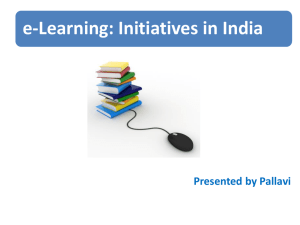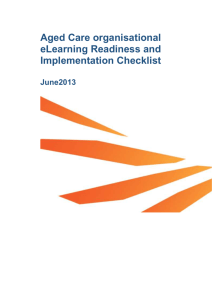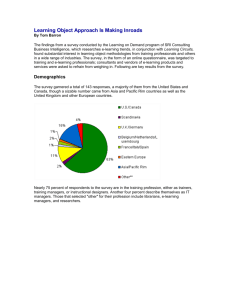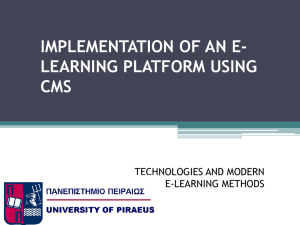59_Lee Yoke et al_E-learning Readiness among Young Students in
advertisement
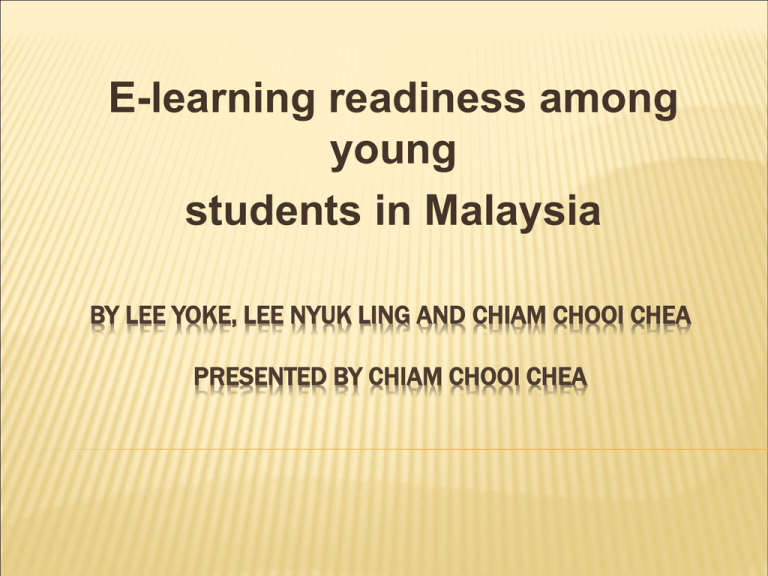
E-learning readiness among young students in Malaysia BY LEE YOKE, LEE NYUK LING AND CHIAM CHOOI CHEA PRESENTED BY CHIAM CHOOI CHEA INTRODUCTION E-learning has received numerous attentions from higher education because the need to change the mode of learning and e-learning has become an increasingly important part of higher education today. Information technology (IT) has been viewed as a solution to students’ distance, time and cost. IT in teaching and learning has created a need to transform how university students learn by using more modern, efficient, and efficient alternative such as e-learning. Due to the rapid growth of web-based technologies and the high usage of the Internet have made teaching and learning via internet, or e-learning, more viable in recent years. THE DIFFERENCES BETWEEN TRADITIONAL DISTANCE LEARNING AND PRESENT E-LEARNING Definition Education paradigm Interaction Traditional distance Present e-learning learning Correspondence Learning anytime teaching; multimedia anywhere, with the use distance learning. of interactive network technologies Passive learners Active Learners Lack of direct Interactions between interaction between the instructor and learner, teacher and the learner and among learners Asynchoronous Asynchoronous/ interaction synchoronous Technology Written or materials printed All electronic media LITERATURE REVIEW Researchers Findings Jefferies & Hussain, (1998); The use of electronic learning Poon et al., 2004) and Volery & (e-learning) as a medium of Lord., (2000). instruction in distance learning is also becoming increasingly important in Malaysia Hong et al. (2003) Students have high level of acceptance with the web-based course. They indicated that the web-based course was convenient and flexible. Nonetheless, some students faced difficulties with the webbased learning environment. LITERATURE REVIEW Researchers Poon et al. (2004) Lee et al.(2010) Asirvatham et al.( 2005) Findings Students in Malaysia were not fully comfortable with elearning. Young students in Malaysia feel that e-learning does not have human touch as compared to traditional class room teaching although most of them have high computer skills and have own website(s) or blog(s) Malaysia is moderately ready for e-learning COMPARISON BETWEEN TRADITIONAL AND OPEN AND DISTANCE LEARNING Traditional learning ODL learning Flexibility DOES NOT EXIST EXIST Geographical coverage ONE specific location ANYWHERE in the world Delivery method Face-to-face Online, learning Learning tools Classrooms Chatrooms, emails, forums, bulletin boards, network websites etc blended BACKGROUND OF THE STUDY A total of 312 young school leavers who are currently undertaking their tertiary education using the traditional classroom in private higher education in Malaysia is the sample for this study. This study aims to study the perception and the level of readiness of the young learners in doing education using the “e” approach. FINDINGS AND DISCUSSIONS Out from the sample, the female and male respondents are of 61% and 39% respectively. The nationality of respondents; 94% are Malaysian and only 6% are foreign respondents. Majority of the respondents are aged between 15-20, followed by respondents aged between 21-25 with 72%. There is a very small number of respondents with an age of above 26. FINDINGS AND DISCUSSIONS There is NO SIGNIFICANT difference the means obtained between gender, age group with the readiness to learn all courses online. The gender have a significant difference perception on the readiness to learn all courses online as the significant level is 0.035. The perception of quality delivered through online is the same as traditional classroom teaching regardless of age for this sample, with significant value of 0.169. FINDINGS AND DISCUSSIONS In summary, based on this study, Malaysian young students are relatively ready to accept elearning for all courses for all aged in this study. Also, Malaysian young students did not perceive any difference in quality in online learning. However, there is a difference in perception on the readiness to do all courses online on gender. CONCLUSION. Based on this study, young students are keen to accept online learning because it can save cost and convenience where they can do their learning anytime anywhere. However, most of them are worry that online learning will have lack of human touch, inadequate interaction between the instructor and the students. END THANK YOU

